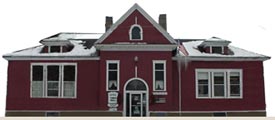The First Settlers
Preble consists of 28 tracts of land which were given to soldiers of the Revolution in lieu of money for service during the war. James Cravith came by foot from Pompey in 1795. He stood on East Hill and saw swampy and dense forest land below in the valley. Cravith didn't like what he saw and went back to Pompey Hill. However, the next year he returned and built the first home (a log cabin) on East Hill.
In 1796 John Gill came over the hill from Scott and settled on West Hill. The first town meeting was held in his home when the town organized. From 1800 the area became populated with people from the Hudson Valley. Land was cleared and farming became the main occupation. Preble Corners, Baltimore, Preble Center, Slab City, Dutch Street, Bennett Hollow are areas of the town where groups of people settled. Preble was originally a part of Tully in Onondaga County.
On April 8, 1808, it separated from Tully and became the northern border of newly formed Cortland County. The population of Preble in 1825 was 1327. The town was named for Commodore Edward Preble, a gallant naval hero of The Barbary Wars.
Building Schools
Education was very important to our early townspeople. As soon as a small settlement was established, a school was soon built. The eastern part of town was more heavily populated at first and the earliest school was built in 1801 on East Hill. A total of eleven districts were operating in many areas of the town.
Preble Town HallAs the town grew, a larger more modern building was erected on Preble Road. Several smaller schools closed and the pupils went to the bigger village school until it closed in 1906. A new school was then built in the center of town. This later centralized with the Homer School District and operated until 1954. Today it houses the post office and town offices. It continues to be painted red and is a gathering place and pictoral part of the town.
Post Office
The closest post office for our early pioneers was situated at Pompey. The first post office was opened in Baltimore in 1812. Preble Corners became more prosperous and in 1832 the post office was moved there. As the town grew, it was located in various homes and stores in the village. For the past several years it continues to service townspeople in the Town Hall on Preble Road.
The Boulder
A World War Memorial was erected on Memorial Day, May 30, 1937, in memory of Mark J. McCauliffe and to the men of Preble who served in World War I. For many years, the people in town had sought some kind of memorial. The Preble Firemen re-awakened the interest and members of the Town Board, led by Supervisor Elmer J. Anderson, began the labor of creating a memorial. It was a huge boulder moved from West Hill, a distance of more than a mile. A bronze plaque was attached with the names of the Preble war veterans.
Glen VanPatten, head of the town veterans and members of the Burns-McCauliffe Post in Homer arranged the ceremony. The parade formed in front of the Preble school and moved to the cemetery for ceremonies honoring the dead. Then it returned to the boulder where the dedication took place. Following World War II, a similar plaque was attached with the names of the veterans from that war. Glen VanPatten was a veteran of both wars and his name appears on both plaques.
In May, 1983, a tree was planted in honor to those town veterans who served in the Korean War and Vietnam. A custom that started with the first observance honoring veterans continues today... all children and parade participants are treated to ice cream at the end of the parade.
An Agricultural Community
Preble has always been famous for its rich soil and dairy farming. The first Holstein cows in Cortland County were introduced by Millard Nye, a noted Preble farmer. The first cabbage seeds were brought by Perry Haynes in 1885 and Preble soon became the largest cabbage growing area in Central New York.
The first Preble Milk Producers Inc., was organized in 1924. In February, 1940 the Preble Milk Co-Operative was formed. A milk plant was built and milk was brought by cans by the producers until 1969. At that time, it was converted to bulk pick up at the farms. Today it continues to operate as a very successful business serving our area farmers.
Preble NY Today
Preble has now entered into the next century. We have grown and changed. No doubt about it. Interstate 81 now zooms through the valley. We have a growing population around our lakes. Preble Park offers us recreation as does Song Mountain. Many of our people commute to jobs in other towns and cities. Some have relocated to other areas, but new families move here and we all care deeply about our great town.
Historic Timeline
1804 — Preble Congregational Church UICC
1812 — Preble's first Post Office located in Little Baltimore
1865 — Preble Hotel was built
1868 — Elmwood Cemetery was organized
1885 — Perry Haynes planted the first acre of cabbage in Preble. This was also the first acre of cabbage planted in Cortland County.
1927 — The Boulder was dedicated on Memorial Day for World War I veterans. At the end of World War II a plaque was added to honor those veterans. Glen Van Patten's name is on both plaques.
1928 — Preble Fire District leased land to house fire equipment
1930 — Preble Fire Department was formed
1940 — Preble Milk Cooperative was organized.
1954 — Preble Fire Department Auxiliary was formed with 38 active members.
1983 — Present Charlie Randall Barber Shop opened.

